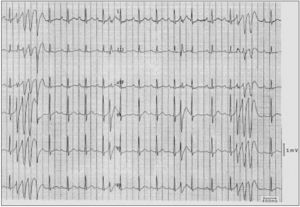Puzzle 2004 2 73, A fainting lady with some extrasystoles - Answer
| Author(s) | A.A.M. Wilde and H. Tan | |
| NHJ edition: | 2004:2,73 | |
| These Rhythm Puzzles have been published in the Netherlands Heart Journal and are reproduced here under the prevailing creative commons license with permission from the publisher, Bohn Stafleu Van Loghum. | ||
| The ECG can be enlarged twice by clicking on the image and it's first enlargement | ||
A30-year-old woman presents with repeated syncope. Her symptoms started a few months ago without a particular trigger. The repeated episodes are not preceded by triggers either. Occasionally she experiences some palpitations followed by dizziness or syncope. She feels healthy otherwise, has no relevant medical history and is not taking any medication. Physical examination reveals no abnormalities, nor does laboratory investigation or echocardiography. Her ECG is presented: leads II, III, aVF, and V4 to V6 are shown, calibration is given in the margin.
What is your diagnosis and what would your treatment be?
Answer
The ECG shows a sinus rhythm of 100 beats/min. The electrical axis is intermediate (positive QRS complexes in leads I and aVF). The PQ interval is slightly prolonged; the QRS width and morphology are normal. The ST-T segment looks normal and the QT interval is certainly not prolonged. There are two episodes of tachycardia with four broad QRS complexes and two isolated broad complexes with a similar morphology as the initiating beats of the tachycardia. The first two episodes have a changing morphology resembling torsades de pointes (TdP) and pointing to a ventricular origin. However, there are four important differences from what is usually referred to as TdP.
- There is no long QT interval and
- the arrhythmia is not preceded by a pause; TdP is a polymorphic ventricular arrhythmia almost exclusively encountered in the setting of prolongation of the QT interval and preceded by a pause.
- The rate is very high (up to 300 beats/min); typically, TdP has a rate of 220 beats/min.
- The coupling interval of the initiating beat is extremely short; TdP in the setting of a prolonged QT interval is always initiated by a premature beat with a long coupling interval, originating from the descending part of the prolonged T wave or from a pronounced U wave; the preceding pause further prolongs the QT interval and the usual initiating sequence is a long-short-long sequence. The extremely short coupling interval of the initiating beats (± 240 ms in this case) is the hallmark of this arrhythmia, which is known as short-coupled torsades de pointes.1 Males and females are equally affected and the mean age is 35 years of age. The family history is often positive for sudden cardiac death. The prognosis is poor when left untreated. The arrhythmias in the setting of this syndrome do not respond reliably to any antiarrhythmic drug. Hence, ICD treatment is mandatory. It is important to state that the occurrence of just one such short-coupled extrasystole (≤300 ms) in a fainting patient (e.g. at 24-hour monitoring) should raise the suspicion of this malignant arrhythmia syndrome. Such short coupling intervals are otherwise only ever seen in acute myocardial ischaemia.
Recently, it has been suggested that the arrhythmia may be cured by radiofrequency catheter ablation.[1] Indeed, the monomorphic appearance of the initiating extrasystoles suggests a localised ventricular origin. Electrophysiological studies in these patients revealed that the origin was in the specialised conduction system and that targeted ablation of the initiating extrasystole was feasible (with favourable effects on arrhythmia recurrence). Long-term follow-up has to be awaited before the patient can be discharged without an ICD.[2]
References
<biblio>
- Leenhardt pmid=8281648
- Haissaguerre pmid=12186801
<biblio>
